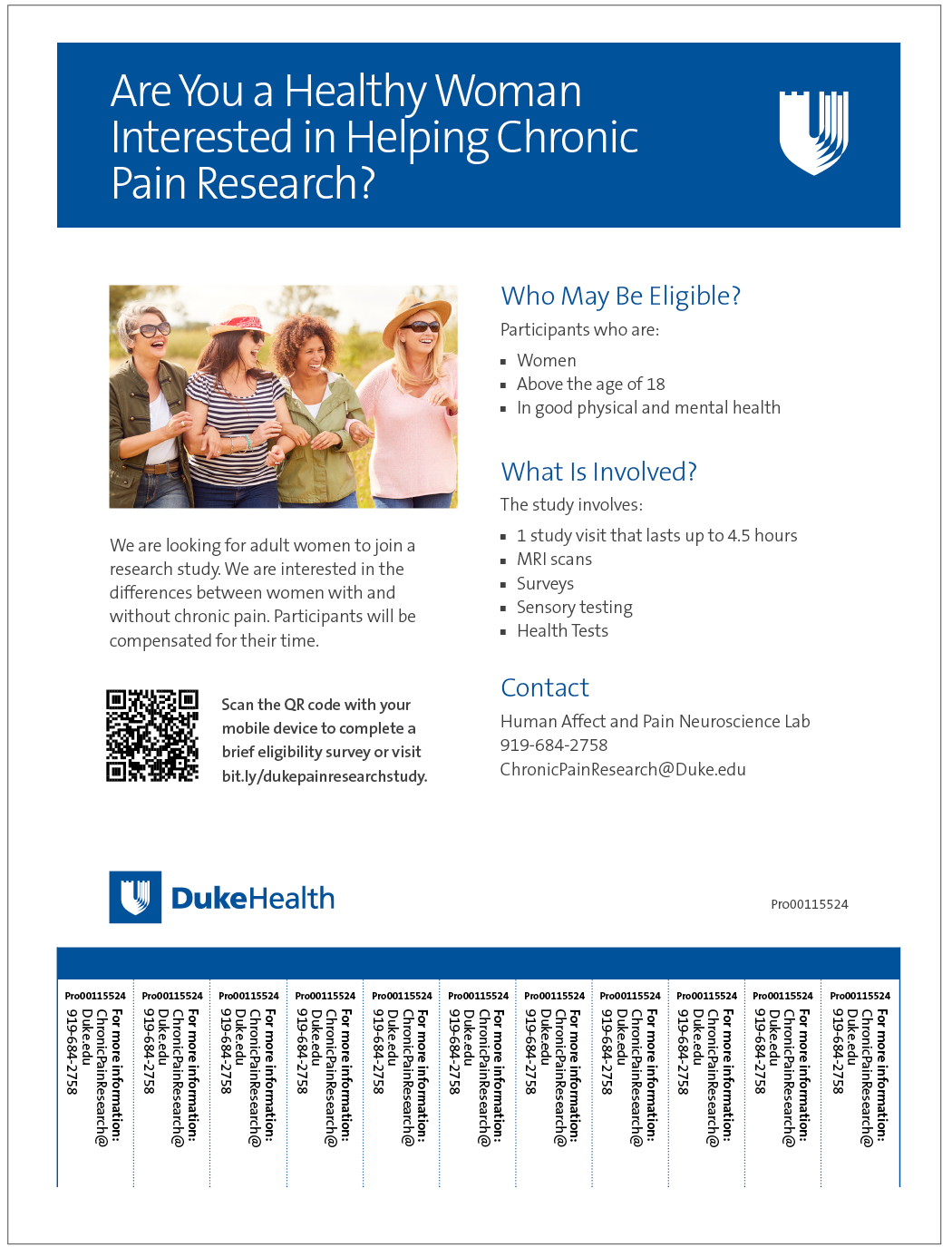Clinical research relies on volunteer participation. All participant materials including flyers, ads, social media, and consent forms should be clear, engaging, and written in plain language. These materials also must adhere to the Duke Health brand guidelines, which includes following our standards for font, color, and style.
The Federal Drug Administration and Institutional Review Board view recruitment materials as the start of informed consent. You may advertise a Duke study but cannot claim or imply health benefits from participation.
For some quick tips on what materials are reviewed by which entities for which reasons, please download this reference guide.

Logo Use
Any clinical recruitment materials targeted to members of the community, patients or participants of any kind should use the Duke Health logo.
Logos cannot be created for individual studies. The Duke Health logo or an approved Duke Health clinical service logo should be used to represent your study on all recruitment materials. Even if the study or trial is being conducted through the Duke University School of Medicine or Duke University School of Nursing, any public-facing materials must use a Duke Health logo.
Duke Health does not allow endorsements with other organizations. However, in a situation where Duke is collaborating with another organization on the study or trial, both logos can be used if there is a qualifying line listed above the Duke logo. For example, "Sponsored by" or "Study in collaboration with." A line like this would be needed any time a Duke logo is used with an outside organization's logo. The logos should also be spaced adequately from each other.
Adult and minor consent forms are considered legal documents, which can use the Duke University Health System (DUHS) logo at the top. This is the only use case where the DUHS logo can be used.
Readability
Readability involves both reading level and ease.
Participant-facing materials that advertise or explain clinical research should be written at a 6th-8th grade reading level at minimum. Strive for 5th grade when you can.
Paragraphs should be no longer than three sentences, and sentences should be short—ideally under 10 words and focused on one idea. Use bullets when possible to simplify content and improve visual clarity. Use plain, lay-friendly language and avoid medical jargon. Resources are available to support the use of plain language:
- Duke University Medical Center Library and Archives Health Literacy Resource
- CDC Plain Language Materials and Resources
- University of Michigan Plain Language Medical Dictionary
- Health Literacy in Clinical Research Resource
- Plain Language Alternatives for Medical Jargon
Content
- Use first person (“we”) and active voice.
- Avoid words with more than three syllables.
- Include white space to improve readability.
- Format phone numbers with hyphens; no parentheses (e.g., 919-999-9999).
- Remove “www” and “https://” from URLs; capitalize words (e.g., DukeHealth.org).
Style
All materials should follow the Duke Health brand guidelines on style. Below are some common do’s and don’ts for style on recruitment materials.
Use colors from the approved Duke Health color palette, ensuring Duke Royal Blue is the most prominent color in your materials.
Headlines should be either Duke Royal Blue or black. Body copy should be black. Type should always be Duke Royal Blue or black.
Photos used should be lifestyle photos or photos that represent the demographic of the community being recruited. Photos not accepted include:
- Clip art graphics
- 3D art
- Photos of medical equipment, procedures, or internal organs (ex: syringes, blood, IV bags, depictions of internal organs or body parts)
- Photo collages
- Use of stock imagery to portray members of our care team
- Black and white photography
Need Help with a Clinical Research Study? |




